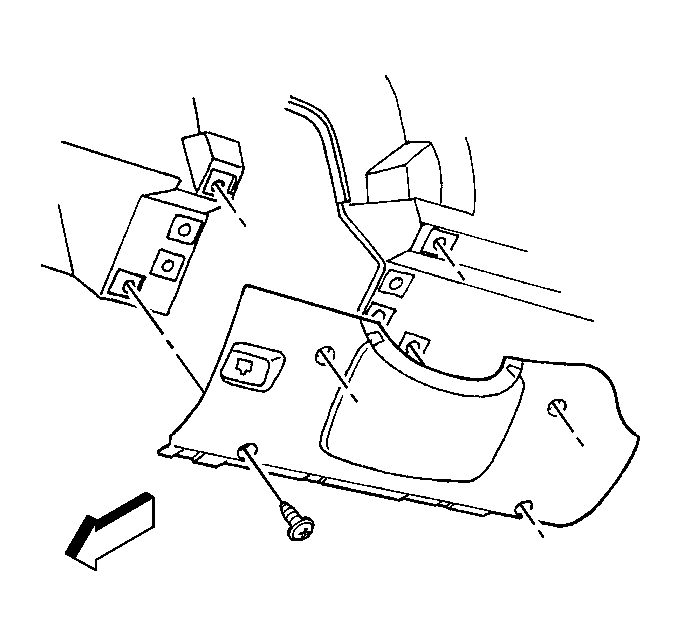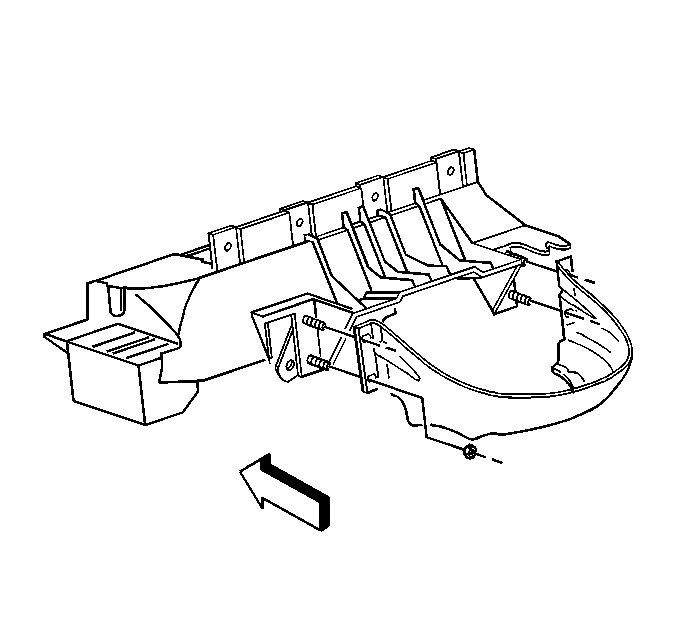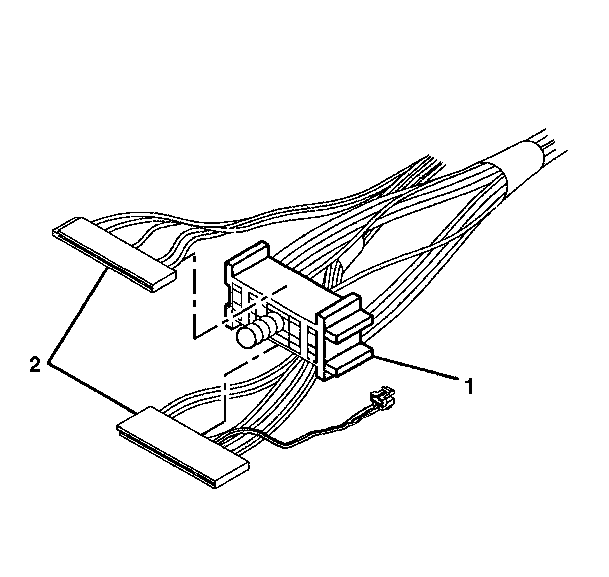Security Lamp Illuminated on the IP, Engine Stalls, No Start, DTC B2960 (Security System Sensor Data Incorrect But Valid) Set (Inspect and Repair Cause of DTC B2960)

| Subject: | Security Lamp Illuminated on the IP, Engine Stalls, No Start, DTC B2960 (Security System Sensor Data Incorrect but Valid) Set (Inspect and Repair Cause of DTC B2960) |
| Models: | 1998-2001 Chevrolet and GMC S/T Pickup and Utility Models (S10, Sonoma, Blazer, Jimmy) |
| 1998-2001 Oldsmobile Bravada |
This bulletin is being revised to add information on inspecting for electrical intermittent conditions and important connector C211 tightening steps. Please discard Corporate Bulletin Number 01-08-56-001 (Section 08 - Body and Accessories).
Condition
Some customers may comment on the following conditions. These symptoms may be intermittent.
| • | Security lamp illuminates while driving. The Security lamp may be On or Off. |
| • | Security lamp is illuminated. |
| • | The engine cranks but will not start and the Security lamp is flashing. |
| • | The engine starts then stalls and the Security lamp is flashing. |
Cause
Condition(s) may be due to an incorrect Passlock™ sensor voltage (which is intermittent) received by the body control module (BCM) from the Passlock™ sensor due to the following conditions. Most intermittent conditions are caused by faulty electrical connections or wiring.
| • | A 7 ohm variation in the sensor ground circuit wiring, circuit 1057 |
| • | A 100 ohm variation in the Passlock™ sensor signal wiring circuit, circuit 1836 |
Inspect for the following items:
| • | Broken wiring inside the insulation. |
| • | A poor connection between the male and female terminal at a connector. Refer to Testing for Proper Terminal Contact under Testing for Intermittent and Poor Connections in Wiring Systems for the specific procedure. |
| • | A poor terminal to wire connection. Some conditions that fall under this description include poor crimps, poor solder joints, crimping over the wire insulation instead of the wire itself, and corrosion in the wire to terminal contact area. |
| • | Wire insulation that is rubbed through. This causes an intermittent short as the bare area touches other wiring or parts of the vehicle. |
| • | A poor connection between the male and female terminal at a connector. This poor connection may be the result of contamination or deformation. |
| • | Contamination may be caused by the connector halves being improperly connected. A missing or damaged connector seal, damage to the connector itself, or exposing the terminals to moisture and dirt can also cause contamination. Contamination, usually in the underhood or underbody connectors, leads to terminal corrosion, causing an open circuit or intermittently open circuit. |
| - | Separate the connector halves. |
| - | Visually inspect the connector halves for contamination. Contamination may result in a white or green build-up within the connector body or between terminals. This causes high terminal resistance, intermittent contact, or an open circuit. An underhood or underbody connector that shows signs of contamination should be replaced in its entirety including the terminals, the seals, and the connector body. |
| • | Deformation is caused by probing the mating surface of a connector terminal without the proper adapter, improperly joining the connector halves, or repeatedly separating and joining the connector halves. Deformation, usually to the female terminal contact tang, can result in poor terminal contact causing an open or intermittently open circuit. Using an equivalent male terminal from the J 38125-B, test that the retention force is significantly different between a good terminal and a suspect terminal. Replace the female terminal in question. |
Correction
Have any of the following components had service recently?
| • | The BCM |
| • | The ignition lock cylinder case assembly |
| • | The PCM/VCM |
If any of the above components have been replaced, the Passlock™ Reprogramming Seed and Key (10 Minute Re-Learn) procedure must be performed before any diagnostic procedures are performed.
To assist in diagnosis, the following steps are provided.
- Does the crank but not start? If yes, use the Engine Cranks but Does Not Run diagnostic information in the Engine Controls sub-section of the applicable Service Manual.
- Observe the security indicator lamp in the top right corner of the instrument panel when you turn the key to the RUN position. Does the indicator lamp show any of the following conditions?
| • | Lamp is On for 5 seconds, then goes Off. This is normal operation. The engine should start and run. |
| • | Lamp is On and does not go Off. A problem is detected but the engine starts. This indicates that the fault occurred when the engine was running. |
| • | Lamp does not come On. This is abnormal operation. Use the Security Indicator Inoperative diagnostic in the Theft Deterrent sub-section of the applicable Service Manual. |
| • | Lamp flashes On and Off. This indicates a problem has been detected this key cycle by the Passlock™ system and the engine may not start. |
Important: You must diagnose the diagnostic trouble codes (DTCs) in the order specified
in the DTC table shown below. Failure to do so may result in one or more of
the following conditions:
• Extended diagnostic time • Incorrect diagnosis • Incorrect parts replacement
DTC | Description | MIL Illuminated |
|---|---|---|
U1255 | Class 2 Communication Malfunction | -- |
U1301 | Class 2 Data Link High | -- |
U1016 | Lost Communication with Engine Control System | -- |
B3031 | Security System Controller in Learn Mode | Security |
B3033 | Security System Indicates Tamper | Security |
B2958 | Security System Sensor Data Circuit High | Security |
B2957 | Security System Sensor Data Circuit Low | Security |
B2960 | Security System Sensor Data Incorrect But Valid | Security |
B2948 | Security System Sensor Power Circuit High | Security |
B2947 | Security System Sensor Power Circuit Low | Security |
(*) BCM DTCs may appear in Passlock™ System DTC list. Record the BCM DTCs before clearing Passlock™ Codes. | ||
If none of the above items are true, proceed with the following steps:
- Install seat covers.
- Connect the scan tool to the diagnostic link connector (DLC).
- Enter scan tool diagnostics.
- Select the model year of the vehicle.
- Select light truck.
- Select F1, (Body)
- Select "S" or "T" for Series.
- Select proper body style.
- Select F0, Body Control Module.
- Select F0, (Diagnostic Trouble Codes (DTC)).
- Select F0, (DTC information).
- Select F0, (Current DTC).
- Record on the repair order any current DTCs displayed. If none, skip the next step.
- Is a current B2960 DTC displayed? If no, the condition is not present with this key cycle. The condition is Intermittent. Continue to the next step.
- Select Exit.
- Select F1, (History DTC).
- Are any history DTCs other than B2960 present? If so, diagnose those DTCs first using the appropriate service information, otherwise continue.
- Select Exit.
- Select Exit.
- Select F1, Data Display.
- Select F6, Security.
- Cycle the key to the OFF position and wait 20 seconds.
- Slowly turn the key to the RUN position. Be careful not to turn the key into the START position.
- Observe the following values:
- Rotate the key to the START position, and observe the following again:
- If no trouble is found and the customer has experienced one of the symptoms or the code is a history DTC, the most likely cause is the Passlock™ wiring, specifically the wires from the Passlock™ sensor to the BCM, specifically the 48 way wiring harness connector.
- Open the hood.
- Disconnect the negative battery cable.
- Install fender covers.
- Air bag deployment
- Personal injury
- Unnecessary SIR system repairs
- In order to avoid the above conditions, observe the following guidelines:
- Remove the left sound insulator, if equipped.
- Remove the knee bolster trim panel.
- Remove the four knee bolster retaining nuts.
- Loosen the screw holding the wiring harness connectors together at connector C211. C211 is the connector for the steering column wires to the IP wiring harness on the left side of the column about half way down. It is a 48-way connector with a center retaining screw. Separate the connection.
- Separate the turn signal and multifunction switch harness (2) from the 18-way connector (1). They have a locking tab in the center of each connector that needs to be released.
- Circuit number 1057, Orange with Black stripe wire, in cavity C4.
- On the end of the 18-way connector is the date the ignition switch wiring harness was manufactured. This date is etched in the plastic of the connector. It is displayed as two lines of numbers (i.e.: GM XXX, XXXX). The bottom row of 4 digits are the 4 digits which must be verified. The following defines the 4 digits:
- If the date code is less than N080, (November 08, 2000), carefully solder the terminals to the wires in the following connector cavities of the ignition switch 18-way connector. A small drop of solder on each terminal is all that is required. Do not allow the solder to wick under the insulation of the wires.
- Connect the turn signal and multifunction switch harness (2) to the 18-way connector (1). Tighten the screw holding the wiring harness connectors together at the junction.
- Cycle the steering column tilt from full up to full down a minimum of ten times.
- Squeeze the ends of connector C211 together with your fingers, forcing the terminals and connector to properly seat together.
- Recheck the retaining screw for connector C211 torque.
- Again, cycle the steering column tilt from full up to full down a minimum of ten times.
- Again, squeeze the ends of connector C211 together with your fingers, forcing the terminals and connector to properly seat together.
- Recheck the retaining screw for connector C211 torque.
- Again, cycle the steering column tilt from full up to full down a minimum of ten times.
- Again, squeeze the ends of connector C211 together with your fingers, forcing the terminals and connector to properly seat together.
- Recheck the retaining screw for connector C211 torque.
- Install the knee bolster to the IP.
- Install the knee bolster trim panel to the IP.
- Be sure the key is not in the ignition switch.
- Connect the passenger yellow 2-way connector and install the connector position assurance (CPA).
- Connect the driver yellow 2-way connector located at the base of the steering column and install the connector position assurance (CPA).
- Install the SIR fuse to the IP fuse block.
- Install the sound insulator panel, if equipped.
- Connect the negative battery cable.
- Observe the Security indicator lamp when the key is turned to the RUN position. The Security lamp should come On for 5 seconds then go Off. If it doesn't, you must recheck your work.
- Observe the SIR lamp. The lamp should be Off.
- Remove the fender covers and close the hood.
- Remove the seat covers.
| • | Passlock™ Data Voltage should be 5.0 volts. |
| • | Passlock™ State should be Normal. |
| • | Passlock™ Code should be Open. |
| • | Passlock™ Data Voltage should be less than 5.0 volts. Passlock™ Data Voltage should remain steady and not fluctuate. The test vehicle used for this diagnostic procedure had a voltage value of 3.92 volts. The vehicle being worked on may be either higher or lower than this value. The key is that it has to be less than 5.0 volts. |
| • | Passlock™ State should be "Monitor Passlock™". |
| • | Passlock™ Code should be Valid Code. |
Caution: This vehicle is equipped with a Supplemental Inflatable Restraint (SIR)
System. Failure to follow the correct procedure could cause the following
conditions:
| • | Turn the steering wheel so that the vehicle's wheels are pointing straight ahead. |
| • | Turn the ignition switch to the LOCK position. |
| • | Remove the key from the ignition switch. |
| Important: With the SIR fuse removed and the ignition switch in the ON position, the AIR BAG warning lamp illuminates. This is normal operation and does not indicate a SIR system malfunction. |
| • | Remove the SIR fuse from the IP fuse block. |



Important: For all vehicles, use either the correct mating terminal, or electrical tool GM# 12094430, (J 38125-11A) from the J 38125-B Terminal Repair kit. Perform a pull test to determine if the terminals have proper tension. If one is found where the tension is suspect, replace the terminal.
Circuit number 812, Red with White stripe wire, in cavity C2.
Circuit number 1836, Yellow wire, in cavity D3.
| • | Month (1) Alpha Character (J = January, A = April, O = October, N = November, etc.) |
| • | Day (2) numbers (1-31) |
| • | Year (1) Number (9 =1999, 0 = 2000) |
| • | Circuit number 1057, Orange with Black stripe wire, in cavity C4 |
| • | Circuit number 812, Red with White stripe wire, in cavity C2 |
| • | Circuit number 1836, Yellow wire, in cavity D3 |

Important: Connector bolt torque is critical. Tightening the bolt to 7 N·m (61 lb in) may cause the pal nut of the connector to strip. Tightening the bolt less than 4 N·m (35 lb in) may result in an intermittent connection.
Tighten
Tighten the retaining screw to 6 N·m (53 lb in).
Tighten
Tighten the retaining screw to 6 N·m (53 lb in).
Tighten
Tighten the retaining screw to 6 N·m (53 lb in).
Tighten
Tighten the retaining screw to 6 N·m (53 lb in).
Tighten
Tighten the nuts to 10 N·m (89 lb in).
| • | Connect the brake release cable to the park brake assembly. |
| • | Install the screws that retain the knee bolster trim panel to the instrument panel. |
Tighten
| • | Tighten the TORX® screws to 9 N·m (80 lb in). |
| • | Tighten the hex head screws to 1.9 N·m (17 lb in). |
| • | Position the courtesy lamp and install the retaining screw. |
Tighten
Tighten the socket retaining screw to 1.4 N·m (12 lb in).
Warranty Information
For vehicles repaired under warranty, use:
Labor Operation | Description | Labor Time |
|---|---|---|
N6626 | Wiring and/or Connector Repair - Theft Deterrent | 0.9 hr |
